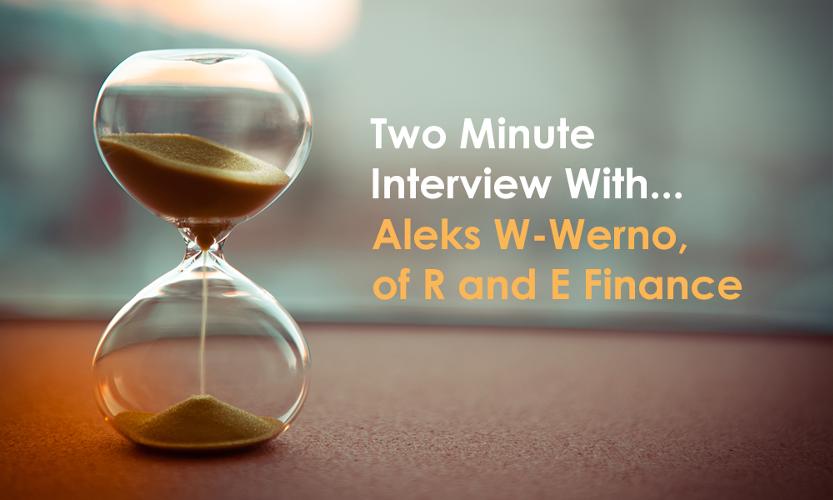
Catherine Spode

Aleks W-Werno
The UK Housing market and Finance
CS It is estimated that some three to four hundred thousand homes need to be built in the UK per annum. How do you think R and E Finance can help deliver homes for ordinary people in the UK?
AW We work with developers helping them to fund a wide variety of housing schemes. We do that through “stacking up”, finance coming from private HNWs, family offices, and banking and finance institutions.
CS This is for ordinary homes?
AW Yes, our finance partners will invest in Private Rental Schemes (PRS) and Build to Rent (BTR) schemes. Some of them focus on projects in the affordable or first-time buyer type of schemes across UK city hubs.
CS Would this be in addition to traditional bank lending?
AW Yes, traditional banks and “Challenger” banks are part of our 300 strong lender panel. A number of our finance sources will form Joint Venture arrangements with developers, providing equity.
CS How important is that equity contribution?
AW The equity portion is crucial to unlock the required debt funding from reputable lenders in order to make the full funding stack work.
CS Do you see the JV route as a useful way for a developer to move up the ladder in terms of the scale and scope of the projects which can be taken on?
AW Yes, and with sites for development at a premium at the moment, this could be the best way forward.
CS Can you expand on how a JV can work in practice?
AW Yes, essentially there are two basic types of JV. The simplest is where the owner of the site retains an interest in the site and a share in the profits of the final product.
CS How can we help in this scenario?
AW There are all sorts of permutations, subject to agreement between the parties. In this scenario we can arrange lending of up to 90% of the project cost, which makes the project feasible. As we have said, lack of adequate finance is one of the key stumbling blocks for developers.
CS And the second type of JV arrangement?
AW We have private individuals, family offices and, indeed, institutions which will offer funding on a JV basis, or, potentially, purchase units in residential projects prior to them being built.
CS What – for R and E Finance – is an affordable home?
AW We are aware of the Government’s initiative to increase the supply of “affordable homes”, this means housing for families and individuals to purchase, and requires a portion of a given development to be sold at a discount price in comparison with open market valuations.
CS Is this within reasonable mortgage multiples?
AW The final product needs to be what is defined as “easily mortgageable”, which will vary from region to region, typically between £200k-£650k per unit.
CS Going back to the JV arrangements for the developer, do you find there can be some anxiety on the part of developers in considering such a financial arrangement?
AW Yes, there can be some confusion about the responsibilities, and how the profit share would work. Most of our arrangements are on a basis of a 50-50 profit share. Equity investment is considered “high risk” as it is unsecured and, therefore, our investors expect to “double their money”; so, if they were to invest £200k of capital, they would expect that capital to be repaid on project completion and also to receive a share from the profit of circa £400k.
CS As they say, cash is king, and the money is not secured, unlike the senior debt, so that seems fair. Where does the confusion arise?
AW We had a case recently, where the profit was forecast at about £20m. The developer was seeking some £5m equity investment in order to make the project finance work. In this scenario, after the initial capital of £5m were repaid, the equity JV partner would also seek the 50% share from the profit, ie: £10m.
CS So the developer, assuming that the project came in on time and within budget, would end up with some £10m in the bank, ie: 50% of the £20m?
AW Yes, however, the developer was somehow anxious, and said he would make no money on this deal.
CS £10m in his company is hardly shabby, and, even after tax due, would leave substantial contribution to the next project – he would be moving up the ladder, surely.
AW Yes, but the developer had not seen it that way – he thought the £5m capital repayment would also come out of the profit.
CS But the calculation should be that the original equity stake put up by the JV partner is now calculated in the costs?
AW Exactly. Of course, the provider of the equity stake has to be paid back. That equity sum is now regarded as part of the funding stack covering the project costs, along with the land, construction costs, planning, marketing, etc. The profit is, of course, calculated after all costs have been deducted. That profit is then subject to the 50-50 split.
CS Do you think such misconceptions about JVs and how they can work is common, and off-putting for developers?
AW At the present time, developers have many issues on their minds – the cost of sites is soaring in many areas, cost of materials and energy are on the increase, as well as wages – I can understand that looking ahead to how a JV will actually work in 12 to 18 months’ time could put one’s brain into an overload.
CS How can we help?
AW Our business is to work with developers and help them to deliver the projects which they aspire to. We help the developers to calculate the real costs and to get a realistic picture of the GDV (Gross Development Value) so they can proceed with a viable project and go from strength to strength.
CS Is this only for early-stage developers?
AW Depending on the experience and track record of the developer, we can help them to access adequate funding – this can be a development of, for example, four family houses with a GDV of one million pounds, while on a larger scale we can help a seasoned developer to access a two hundred million pound rolling fund to finance some 800 – 1,000 new homes in tranches.
CS Is the application process all plain sailing?
AW We help the applicant to model financial appraisals which are in line with the lender’s requirements. As we communicate with the lenders on a regular basis, we can ensure the application is made in such a way as to ensure a positive response from both debt and equity providers.
CS Is there a charge for the preparation stage?
AW We work on the basis of a “success fee only”; the applicant’s success is our success.
CS What are the key things you look for in an application?
AW The experience and cash contribution of the team does matter. Lenders like to see “skin in the game” from the applicants, and this could mean a cash input of 10% of the project cost – we could potentially arrange 90% of cost funding for them as a loan. In this scenario the developer retains all the profits.
CS What if the developer does not have 10% - which in most cases would mean cash at bank of £200k?
AW We could look at a combination of debt and equity whereby the developer would need to bring enough cash to cover 2% of the project costs, and then they would be sharing the profits with the equity partner – profit calculated after costs, of course.
CS The developer needs to demonstrate faith in their own ability to deliver?
AW Yes, that makes it all more palatable for the equity investor.
CS What are the next steps for a developer eyeing a new project?
AW During the pandemic we learned the use of video conferencing for the early-stage meetings. We are happy to arrange the initial calls – also face to face meetings are gradually returning, and we look forward to working with new applicants.
CS Thank you, Aleks.
For more information please email cs@catherinespodeandassociates.co.uk

